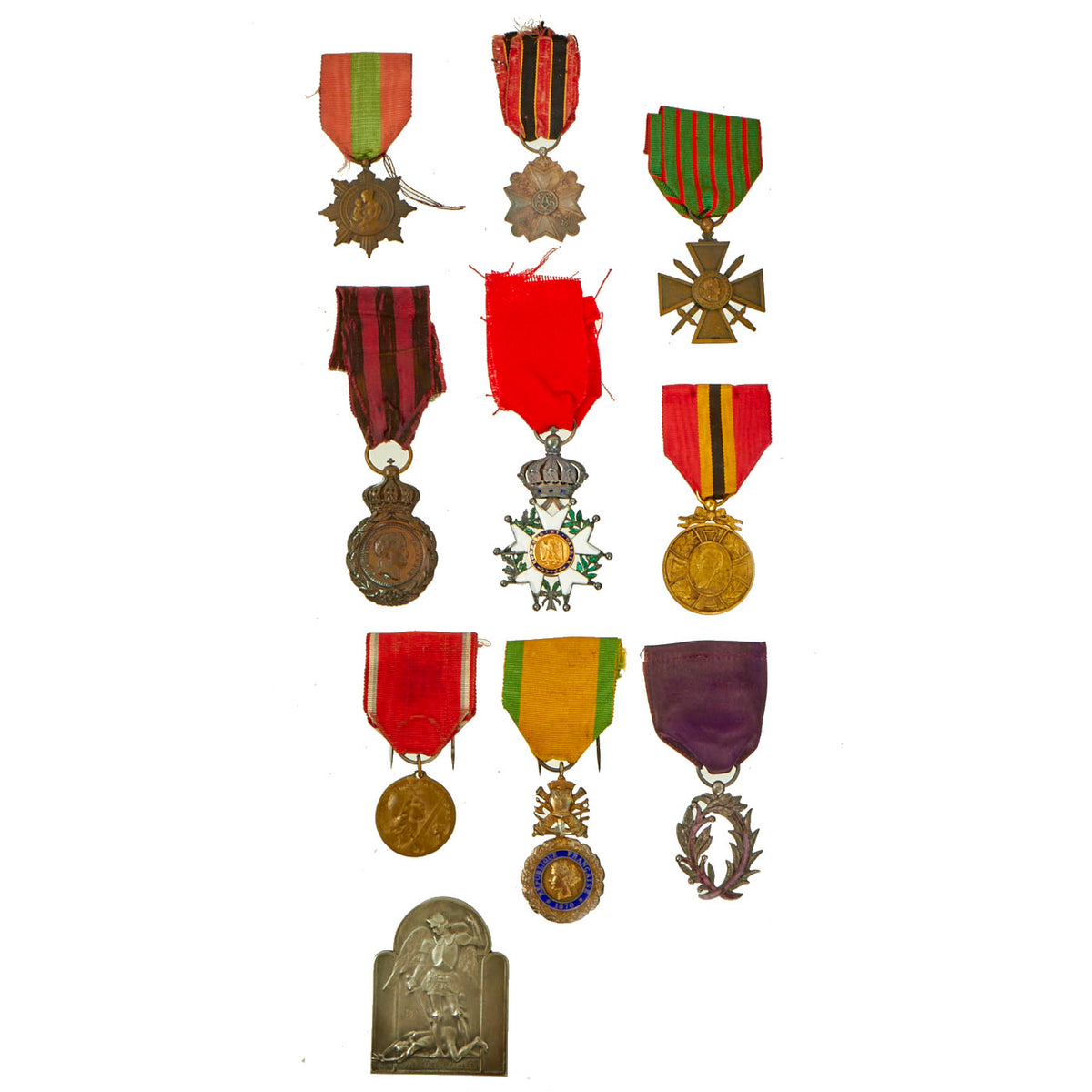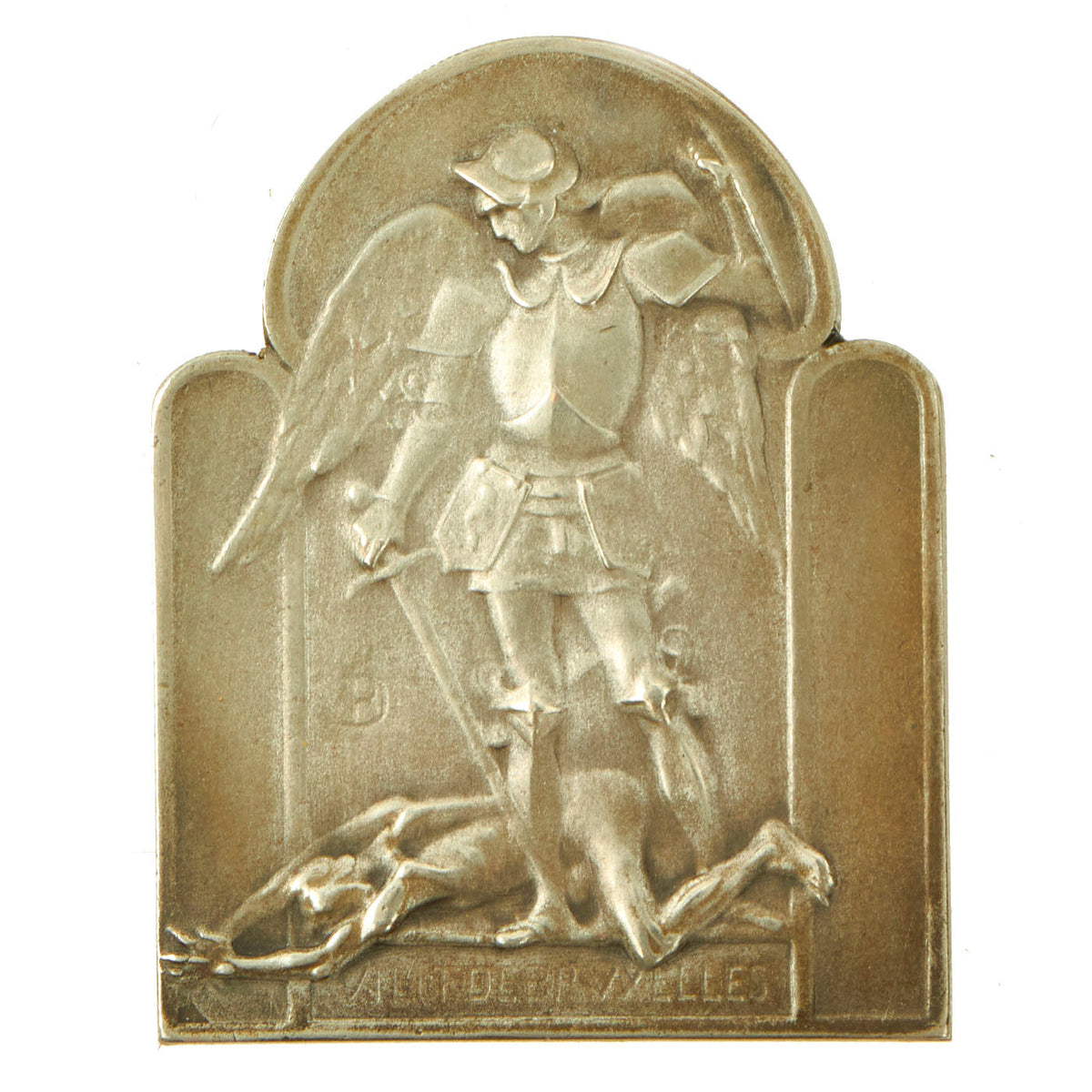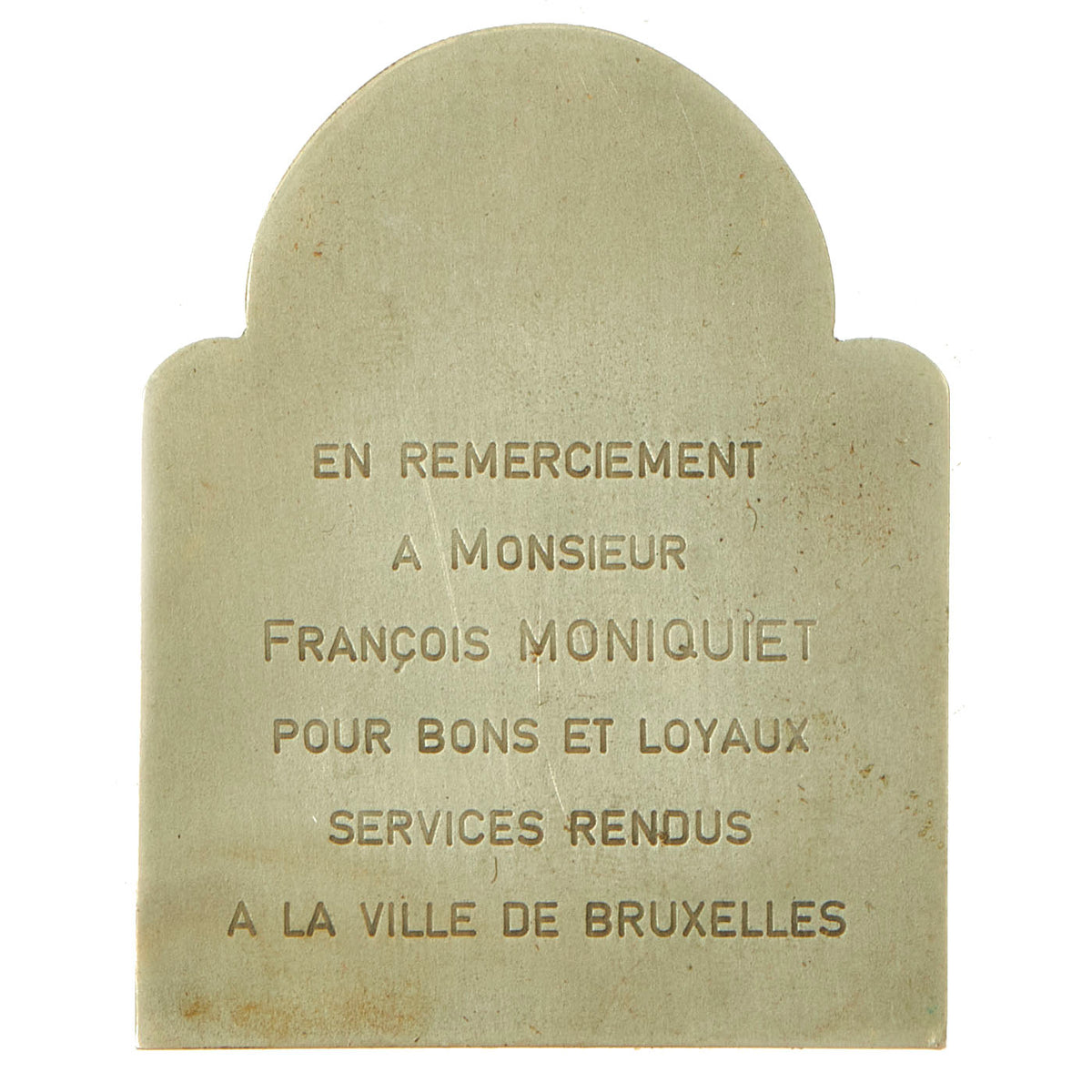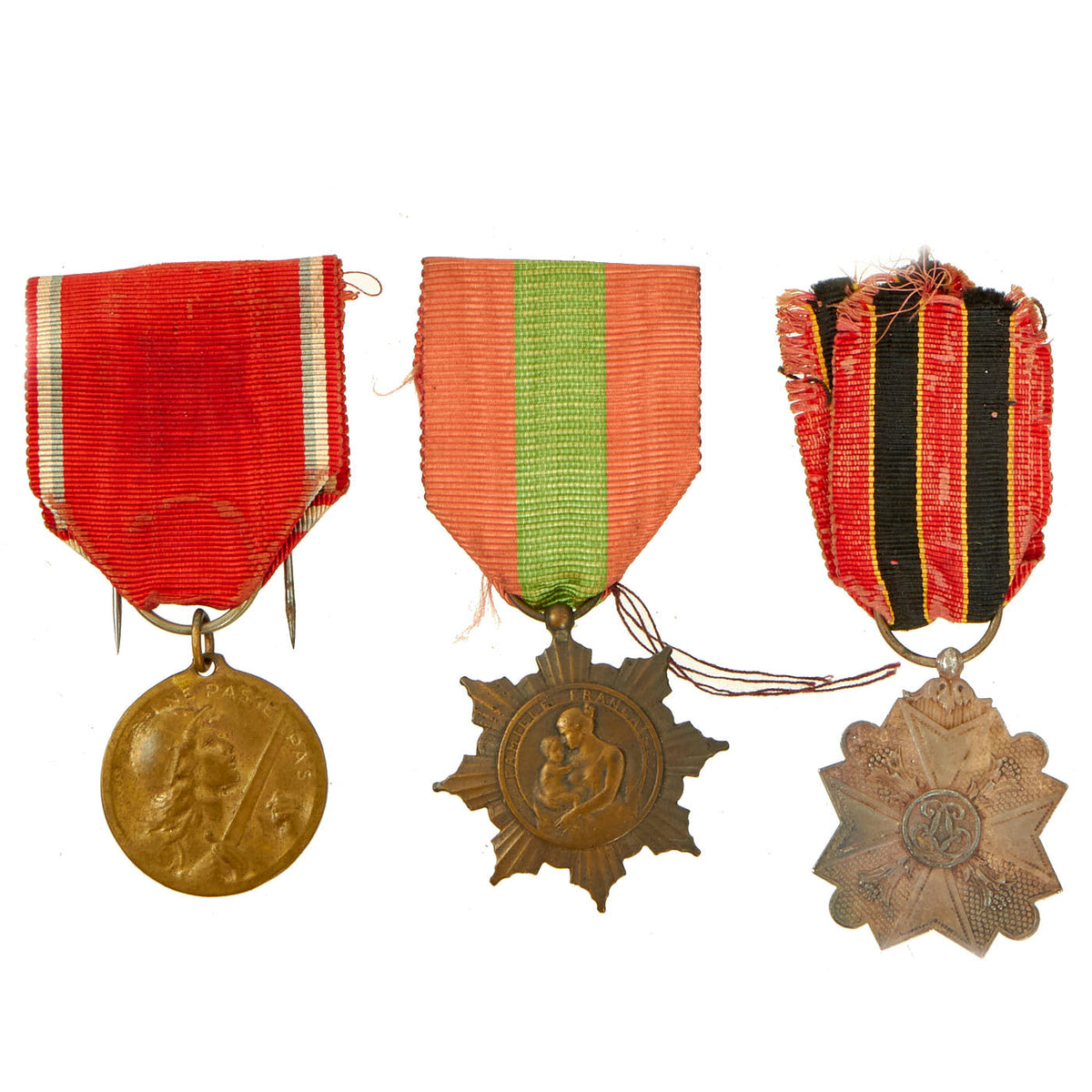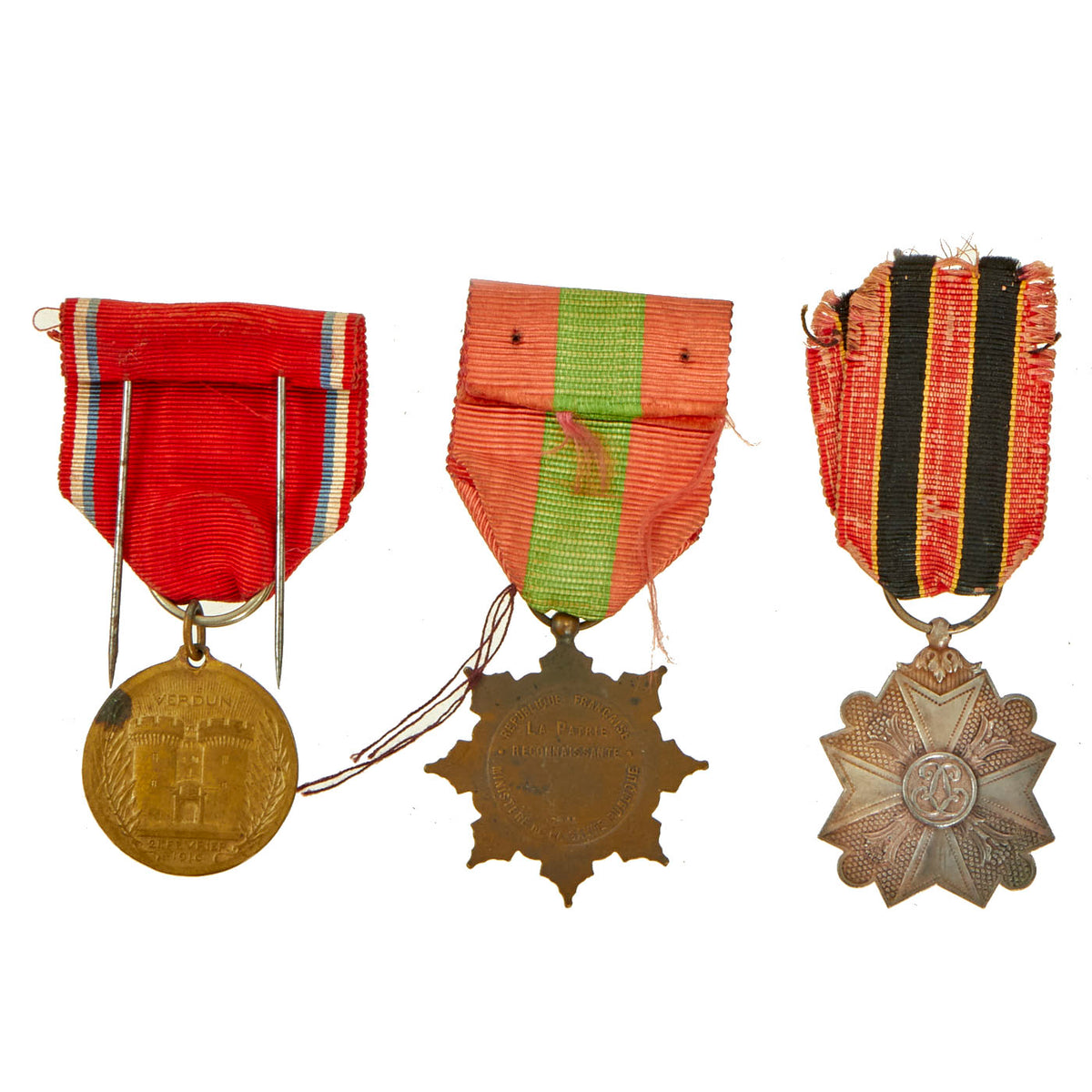Original French & Belgian Pre WWI to WWI Medals and Decoration Lot Featuring The St. Helena Medal, The First French Campaign Medal – 10 Items Original Items
$ 295,00 $ 118,00
Original Items: Only One Lot of 10 Available. In various armed forces across the world, awards and decorations were issued to various personnel for acts of service with prerequisites including bravery, valor, courage, and unprecedented actions. They include service ribbons and medals. Although it was primarily used in standing state armed forces, irregular forces also utilized a similar method.
The Medals In This Lot:
French:
– Croix de guerre 1914–1918: The Croix de guerre 1914–1918 is a French military decoration, the first version of the Croix de Guerre. It was created to recognize French and allied soldiers who were cited for valorous service during World War I, similar to the British mentioned in dispatches but with multiple degrees equivalent to other nations’ decorations for courage. The cross was designed by the sculptor Paul-Albert Bartholomé. It is 37 mm wide, Florentine bronze cross pattée, with two crossed swords pointing up between the arms. The obverse center medallion bears the relief image of the French Republic in the form of the bust of a young woman wearing a Phrygian cap surrounded by the circular relief inscription RÉPUBLIQUE FRANCAISE (FRENCH REPUBLIC). Not knowing how long the war would last, the reverse center medallion bears the dates 1914–1915, 1914–1916, 1914–1917 and finally 1914–1918.
The cross is suspended by a ring through a suspension loop cast atop the upper cross arm. It hangs from a 37 mm wide green silk moiré ribbon with seven narrow 1.5 mm wide vertical red stripes evenly spaced and two 1 mm red edge stripes.
– Battle of Verdun Medal: Created in late 1916 and even before the end of the battle, the Medal of Verdun was made for soldiers who, for several months under intense pressure from infantry attacks and heavy artillery pounding, held their ground during the WW1 Battle of Verdun.
Around 70% of all the French soldiers that were engaged in World War I participated to the battle of Verdun. Six or seven different designs were put forward for the medal but none were approved by the French Government and all remained unofficial awards that could not be worn on military uniform.
Originally intended to be “awarded to those who served on the Verdun front between 21 February 1916 and 2 November 1916, the medal was, in fact, awarded to those who served anywhere on the Argonne and St Mihiel sectors between 31 July 1914 and 11 November 1918.
The medal shows a red ribbon with a French flag supporting a bronze badge. The obverse shows the head of the Republic (a symbol of the IIIrd French Republic) and the famous sentence pronounced by Robert Nivelle: “Ils ne passeront pas”, translated as: they will not break through.
The medal is fitted with a loose ring suspender and a piece of 37 mm red ribbon that has blue-white-red edges.
– Legion of Honor (Knight): The National Order of the Legion of Honour, formerly the Royal Order of the Legion of Honour (Ordre royal de la Légion d’honneur), is the highest French order of merit, both military and civil. Established in 1802 by Napoleon Bonaparte, it has been retained (with occasional slight alterations) by all later French governments and regimes.
The order’s motto is Honneur et Patrie (“Honour and Fatherland”); its seat is the Palais de la Légion d’Honneur next to the Musée d’Orsay, on the left bank of the Seine in Paris.
The order is divided into five degrees of increasing distinction: Chevalier (Knight), Officier (Officer), Commandeur (Commander), Grand officier (Grand Officer) and Grand-croix (Grand Cross).
– Médaille de la Famille française (French Family Medal) In Bronze: The Médaille de la Famille française is a decoration awarded by the government of France to honor those who have successfully raised several children with dignity. The decoration was created by a decree of May 26, 1920, under the name Médaille d’honneur de la famille française, with the aim of honoring mothers of large families. Although the medal rewards those with large families, the children must be “raised well” and the eldest be at least 16 years old.
Three classes of medals exist: bronze for those raising four or five children, silver for parents of six or seven children, and gold for those with eight or more children. A bronze medal is also granted to widowed mothers of three children whose husbands have been killed in action. The recipient’s eldest child must be at least sixteen years old.
The original medal was an eight pointed radiant star (like this example), with a central medallion depicting a mother holding a small child, surrounded by the inscription Famille Française, (“French Family”). Since 1983 a circular medal has been awarded, bearing the words Famille Française above a modernistic image of a couple and their children. The words “République Française” (“French Republic”) are inscribed on the reverse side. The ribbon of both versions is the same, and has three equal parts, the outer two being red and the inner green. Recipients of silver and gold medals are also granted a rosette in the same colors.
– Médaille Militaire: The Médaille militaire is a military decoration of the French Republic for other ranks for meritorious service and acts of bravery in action against an enemy force. It is the third highest award of the French Republic, after the Légion d’honneur, a civil and military order, and the ordre de la Libération, a Second World War-only order. The Médaille militaire is therefore the most senior entirely military active French decoration.
During World War I, 230,000 médailles were awarded, when 1,400,000 French Army soldiers were killed and 3,000,000 wounded. For comparison, the UK Military Medal was awarded on 115,000 occasions in World War I, when 673,375 British Army soldiers were killed and 1,643,469 wounded.
The award was first established in 1852 by the first President of the French Republic, Louis-Napoléon Bonaparte who may have taken his inspiration from a medal established and awarded by his father, Louis Bonaparte, King of Holland.
After the First World War, the Military Medal was also temporarily awarded for wounds received in combat.
The Médaille militaire is a silver laurel wreath, 28 mm (1.1 in) in diameter, wrapped around a central gold medallion bearing the left profile of Marianne, effigy of the French Republic, the original 2nd Empire variant bore the left profile of Emperor Napoleon III. The central gold medallion is surrounded by a blue enameled ring bearing the gilt inscription “RÉPUBLIQUE FRANÇAISE” (English: “FRENCH REPUBLIC”) with a small gilt five-pointed star at the bottom for a 4th Republic award, three stars for a 5th Republic variant, the 3rd Republic variant bore the date 1870, the 2nd Empire variant bore the gilt inscription “LOUIS-NAPOLEON” in lieu of “RÉPUBLIQUE FRANÇAISE” and had flowers on both sides of the small star at the bottom. The original variant was topped by a silver imperial eagle with a loop through which the suspension ring passed, all other variants were and are topped by a device composed of a breastplate superimposed over crossed cannons, a naval anchor, sabres, swords and battle axes, to which the suspension ring passes through a loop for attachment to a ribbon. The reverse of the medallion is common to all variants since inception of the award, it bears the relief inscription on three lines “VALEUR ET DISCIPLINE” (English: “VALOUR AND DISCIPLINE”) and is surrounded by a blue enameled ring.
The ribbon of the Médaille militaire is 37 mm (1.5 in) wide, yellow in color with 6 mm-wide (0.24 in) green stripes on each edge. This ribbon was borrowed from the Order of the Iron Crown which it effectively replaced in France.
– Saint Helena Medal: The Saint Helena Medal was the first French campaign medal. It was established in 1857 by a decree of emperor Napoleon III to recognise participation in the campaigns led by emperor Napoleon I.
Emperor Napoléon I, creator of the Order of the Legion of Honour and various other orders, never instituted commemorative campaign medals for his soldiers. In time, many veterans of these campaigns, sometimes called the “débris de la Grande Armée” (English: “remnants of the Great Army”), began meeting within various new veterans’ associations. Keeping alive their war memories and the myth of Napoléon in popular culture, they issued many unofficial commemorative and associative medals.
It would be forty two years after the last battles and exile of the emperor to the island of Saint Helena before the need to adequately and officially recognise the service of these combat veterans was eventually recognised officially by an imperial decree of Emperor Napoléon III creating, on 12 August 1857, the Saint Helena Medal. According to Fondation Napoléon 450,000 old soldiers were recorded as being alive in the 1850s.
The Saint Helena Medal is of irregular shape and struck from bronze. It is a 2 cm in diameter circular medallion surrounded by a 50mm wide laurel wreath tied with a bow at the bottom. Atop the medal, a 2 cm wide Imperial Crown. The obverse of the medallion bears the relief image of the right profile of Emperor Napoleon I surrounded by the relief inscription “NAPOLÉON I EMPEREUR” (English: “NAPOLÉON I EMPEROR”). A ring or small orbs separates the central medallion from the wreath. Just below the image of the emperor, a small anchor, the privy mark of the award’s designer, Désiré-Albert Barre.
The reverse is identical except for the medallion which bears the relief circular inscription within a narrow 20mm band “CAMPAGNES DE 1792 A 1815” (English: “CAMPAIGNS OF 1792 TO 1815”). In the center, the relief inscription on nine lines “A” “SES” “COMPAGNONS” “DE GLOIRE” “SA DERNIÈRE” “PENSÉE” “STE HÉLÈNE” “5 MAI” “1821” (English: “TO HIS COMPANIONS IN GLORY HIS LAST THOUGHT ST HELENA 5 MAY 1821”).
The medal should hang from a 38mm wide green silk moiré ribbon bearing five 1,8mm wide red vertical stripes spaced 4,5mm apart and 1mm red edge stripes. The ribbon passes through a suspension ring, itself passing through a lateral hole in the imperial crown’s orb atop the medal.
– Ordre des Palmes académiques (Knight): The Ordre des Palmes académiques (French for “Order of Academic Palms”) is a national order bestowed by the French Republic on distinguished academics and teachers and for valuable service to universities, education and science. Originally established in 1808 by Emperor Napoleon as a decoration to honor eminent members of the University of Paris, it was changed into its current form as an order of merit on 4 October 1955 by President René Coty, making it one of the oldest civil honors bestowed by the French Republic.
– Brussels Award Medallion: Awarded to Mr. Francois Moniquiet for “good and faithful service to the city of Brussels”.
Belgian
– Civic Decoration: The Civic Decoration is a civilian decoration of the Kingdom of Belgium. It was first established by royal decree on 21 July 1867 to reward exceptional acts of bravery, devotion or humanity. A further royal decree of 15 January 1885 extended the award to state civil servants for long service by a mere change of ribbon. The award statute was once again amended by royal decree in 1902 to include long service in the Civic Guard and firefighters, each with its distinctive ribbon.
Two wartime variants were created to reward civilians who distinguished themselves during the World Wars. The Civic Decoration 1914–1915 (later dated 1918) was created on 18 May 1915 to reward civilians and non-combatants who served their country with distinction during World War I. A similar Decoration was also established for World War II on 21 July 1944 by the Belgian government in exile.
The Civic Decoration, previously solely awarded by Royal Decree, has been awarded directly by regions and communities since the 1993 federalization of Belgium.
– Commemorative Medal of the Reign of King Leopold II FIRST Type: The Commemorative Medal of the Reign of King Leopold II was a Belgian civilian and later military and police forces medal originally established on 21 July 1905 by royal decree to commemorate the 40th year of the reign of King Leopold II.
The medal was initially awarded to civil servants with a minimum of 20 years of honorable service between 1865 and 1905 who were eligible for the Civic Decoration for long service. It was reissued slightly modified in 1951 at the request of veterans’ groups, to veterans and military personnel who had a minimum of one year’s good and faithful service between 16 December 1865 and 18 December 1909. The medal was once again reissued for a third time in 1952, again slightly modified, to members and veterans of the Force Publique who also had a minimum of one year’s good and faithful service between 1 July 1885 and 18 December 1909. The one year’s minimum service requirement was later removed by royal decrees in 1959 and 1960.
The Commemorative Medal of the Reign of King Leopold II was a 33 mm in diameter gilt bronze circular medal. Its obverse bore the relief image of a cross pattée with a central medallion bearing the left profile of King Leopold II; the cross was superimposed over a wreath of laurel and oak branches along the medal’s circumference. The reverse bore the same basic design except for the king’s profile which was replaced by the years inscribed in relief on two rows “1865 1905” for the initial type (1905) awarded to civil servants, “1865 1909” for the second type (1951) awarded to the military and “1885 1909” to the Force Publique (1952).
The medal was suspended by a ring through a ribbon and bow-shaped suspension loop from a 37 mm wide silk moiré red ribbon with a 3 mm wide central black stripe bordered on both sides by 5 mm wide yellow stripes.
All awards vary in condition but are lovely nonetheless.
Comes more than ready for further research and display.
Fast Shipping with Professional Packaging
Thanks to our longstanding association with UPS FedEx DHL, and other major international carriers, we are able to provide a range of shipping options. Our warehouse staff is expertly trained and will wrap your products according to our exact and precise specifications. Prior to shipping, your goods will be thoroughly examined and securely secured. We ship to thousands clients each day across multiple countries. This shows how we're dedicated to be the largest retailer on the internet. Warehouses and distribution centres can be located throughout Europe as well as the USA.
Note: Orders with more than one item will be assigned a processing date depending on the item.
Before shipping before shipping, we'll conduct a thorough inspection of the items you have ordered. Today, the majority of orders will be delivered within 48 hours. The delivery time will be between 3-7 days.
Returns
The stock is dynamic and we cannot completely manage it because multiple stakeholders are involved, including our factory and warehouse. So the actual stock may alter at any time. It's possible that you may not receive your order once the order has been made.
Our policy is valid for a period of 30 days. If you don't receive the product within 30 days, we are not able to issue a refund or an exchange.
You can only return an item if it is unused and in the same state as the day you received it. You must have the item in its original packaging.
Related products
Uncategorized
Uncategorized
Angolan Rebel 1970s era 60mm Inert Display Mortar from Angolan Civil War Original Items
Uncategorized
Australian WWII Owen MK1 Machine Carbine SMG Custom Fabricated Replica with Sling Original Items
Uncategorized
Uncategorized
Uncategorized
Uncategorized
Armored Burgonet Helmet & Polearm from Scottish Castle Leith Hall Circa 1700 Original Items
Uncategorized
Uncategorized
Uncategorized
Uncategorized
Band of Brothers ORIGINAL GERMAN WWII Le. F.H. 18 10.5cm ARTILLERY PIECE Original Items
Uncategorized
Uncategorized
Uncategorized
Uncategorized
Uncategorized
